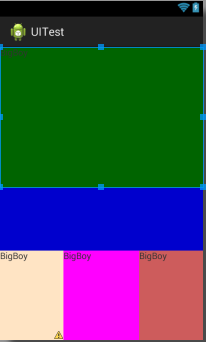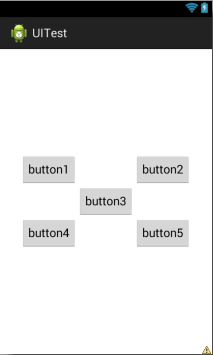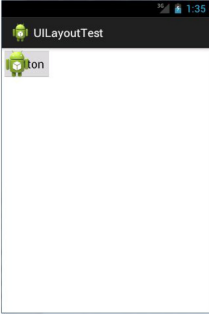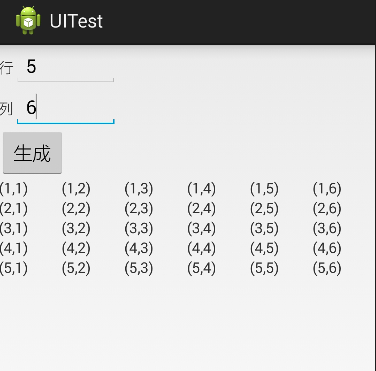Android笔记——Android五大布局
一、五大布局
Android的界面是有布局和组件协同完成的,布局好比是建筑里的框架,而组件则相当于建筑里的砖瓦。组件按照布局的要求依次排列,就组成了用户所看见的界面。Android的五大布局分别是LinearLayout(线性布局)、FrameLayout(单帧布局)、RelativeLayout(相对布局)、AbsoluteLayout(绝对布局)和TableLayout(表格布局)。
二、布局详解
1、LinearLayout:
LinearLayout按照垂直或者水平的顺序依次排列子元素,每一个子元素都位于前一个元素之后。如果是垂直排列,那么将是一个N行单列的结构,每一行只会有一个元素,而不论这个元素的宽度为多少;如果是水平排列,那么将是一个单行N列的结构。如果搭建两行两列的结构,通常的方式是先垂直排列两个元素,每一个元素里再包含一个LinearLayout进行水平排列。
LinearLayout的常用属性:
android:layout_gravity 本元素相对于父元素的重力方向
android:gravity 本元素所有子元素的重力方向
android:orientation 线性布局以列或行来显示内部子元素
android:layout_weight 子元素对未占用空间水平或垂直分配权重值
当 android:orientation="vertical" 时, 只有水平方向的设置才起作用,垂直方向的设置不起作用。即:left,right, center_horizontal 是生效的。!!!!
当 android:orientation="horizontal" 时, 只有垂直方向的设置才起作用,水平方向的设置不起作用。即:top,bottom,center_vertical 是生效的。!!!!
android:layout_gravity 和 android:gravity 的区别
android:gravity对元素本身起作用-本身元素显示在什么位置
android:layout_gravity相对与它的父元素-元素显示在父元素的什么位置。
LinearLayout中的子元素属性android:layout_weight生效,它用于描述该子元素在剩余空间中占有的大小比例。加入一行只有一个文本框,那么它的默认值就为0,如果一行中有两个等长的文本框,那么他们的android:layout_weight值可以是同为1。如果一行中有两个不等长的文本框,那么他们的android:layout_weight值分别为1和2,那么第一个文本框将占据剩余空间的三分之二,第二个文本框将占据剩余空间中的三分之一。android:layout_weight遵循数值越小,重要度越高的原则。显示效果如下
<LinearLayout xmlns:android="http://schemas.android.com/apk/res/android"
android:layout_width="match_parent"
android:layout_height="match_parent"
android:orientation="vertical" > <TextView
android:id="@+id/textView1"
android:layout_width="match_parent"
android:layout_height="wrap_content"
android:layout_weight="0.50"
android:background="#006400"
android:text="@string/boy" /> <TextView
android:id="@+id/textView2"
android:layout_width="match_parent"
android:layout_height="wrap_content"
android:layout_weight="0.2"
android:background="#0000CD" />
<LinearLayout
android:layout_width="match_parent"
android:layout_height="wrap_content"
android:layout_weight="0.3"
android:orientation="horizontal" > <TextView
android:id="@+id/textView3"
android:layout_width="wrap_content"
android:layout_height="match_parent"
android:layout_weight="0.3"
android:background="#FFE4C4"
android:text="@string/boy" /> <TextView
android:id="@+id/textView4"
android:layout_width="wrap_content"
android:layout_height="match_parent"
android:layout_weight="0.4"
android:background="#FF00FF"
android:text="@string/boy" /> <TextView
android:id="@+id/textView5"
android:layout_width="wrap_content"
android:layout_height="match_parent"
android:layout_weight="0.3"
android:background="#CD5C5C"
android:text="@string/boy" /> </LinearLayout> </LinearLayout>

2、RelativeLayout:
RelativeLayout按照各子元素之间的位置关系完成布局。在此布局中的子元素里与位置相关的属性将生效。例如android:layout_below, android:layout_above等。子元素就通过这些属性和各自的ID配合指定位置关系。注意在指定位置关系时,引用的ID必须在引用之前,先被定义,否则将出现异常。
RelativeLayout里常用的位置属性如下:
第一类:属性值为true或false
android:layout_alignParentLeft —— 该组件是否对齐父组件的左端
android:layout_alignParentRight —— 该组件是否齐其父组件的右端
android:layout_alignParentTop —— 该组件是否对齐父组件的顶部
android:layout_alignParentBottom —— 该组件是否对齐父组件的底部
android:layout_centerInParent —— 该组件是否相对于父组件居中
android:layout_centerHorizontal —— 该组件是否横向居中
android:layout_centerVertical —— 该组件是否垂直居中
第二类:属性值必须为id的引用名“@id/id-name”
android:layout_below 在某元素的下方
android:layout_above 在某元素的的上方
android:layout_toLeftOf 在某元素的左边
android:layout_toRightOf 在某元素的右边
第三类:属性值为具体的像素值,如30dip,40px
android:layout_marginBottom 离某元素底边缘的距离
android:layout_marginLeft 离某元素左边缘的距离
android:layout_marginRight 离某元素右边缘的距离
android:layout_marginTop 离某元素上边缘的距离
<LinearLayout xmlns:android="http://schemas.android.com/apk/res/android"
android:layout_width="match_parent"
android:layout_height="match_parent"
android:orientation="vertical" > <TextView
android:id="@+id/textView1"
android:layout_width="match_parent"
android:layout_height="wrap_content"
android:layout_weight="0.50"
android:background="#006400"
android:text="@string/boy" /> <TextView
android:id="@+id/textView2"
android:layout_width="match_parent"
android:layout_height="wrap_content"
android:layout_weight="0.2"
android:background="#0000CD" />
<LinearLayout
android:layout_width="match_parent"
android:layout_height="wrap_content"
android:layout_weight="0.3"
android:orientation="horizontal" > <TextView
android:id="@+id/textView3"
android:layout_width="wrap_content"
android:layout_height="match_parent"
android:layout_weight="0.3"
android:background="#FFE4C4"
android:text="@string/boy" /> <TextView
android:id="@+id/textView4"
android:layout_width="wrap_content"
android:layout_height="match_parent"
android:layout_weight="0.4"
android:background="#FF00FF"
android:text="@string/boy" /> <TextView
android:id="@+id/textView5"
android:layout_width="wrap_content"
android:layout_height="match_parent"
android:layout_weight="0.3"
android:background="#CD5C5C"
android:text="@string/boy" /> </LinearLayout> </LinearLayout>
这次的代码稍微复杂一点,不过仍然是有规律可循的。android:layout_above 属性可以让一个控件位于另一个控件的上方,需要为这个属性指定相对控件 id 的引用,这里我们填入了@id/button3 ,表示让该控件位于 Button 3 的上方。其他的属性也都是相似的,android:layout_below 表示让一个控件位于另一个控件的下方,android:layout_toLeftOf 表示让一个控件位于另一个控件的左侧,android:layout_toRightOf 表示让一个控件位于另一个控件的右侧。注意,当一个控件去引用另一个控件的 id 时,该控件一定要定义在引用控件的后面,不然会出现找不到 id 的情况。

效果图
3、FrameLayout:
FrameLayout是五大布局中最简单的一个布局,在这个布局中,整个界面被当成一块空白备用区域,所有的子元素都不能被指定放置的位置,它们统统放于这块区域的左上角,并且后面的子元素直接覆盖在前面的子元素之上,将前面的子元素部分和全部遮挡。这种布局没有任何的定位方式,所有的控件都会摆放在布局的左上角。显示效果如下,按钮和图片都是位于布局的左上角。由于图片是在按钮之后添加的,因此图片压在了按钮的上面。
<FrameLayout xmlns:android="http://schemas.android.com/apk/res/android"
android:layout_width="match_parent"
android:layout_height="match_parent"> <Button
android:id="@+id/button"
android:layout_width="wrap_content"
android:layout_height="wrap_content"
android:text="Button"/> <ImageView
android:id="@+id/image_view"
android:layout_width="wrap_content"
android:layout_height="wrap_content"
android:src="@drawable/ic_launcher" /> </FrameLayout>

效果图
4、TableLayout
有多少个TableRow对象就有多少行,
列数等于最多子控件的TableRow的列数
直接在TableLayout加控件,控件会占据一行
TableLayout属性(也叫全局属性):*代表所有列
android:shrinkColumns -------设置可收缩的列,(内容过多,则收缩,扩展到第二行,控件没布满TableLayout时不起作用)
android:stretchColumns ------设置可伸展的列,(有空白则填充)
列可以同时具备stretchColumns及shrinkColumns属性
android:collapseColumns ------设置要隐藏的列(索引列从0开始)
内部控件属性:
android:layout_column -------该单元格在第几列显示
android:layout_span -------该单元格占据列数,默认为1
案列:
MainActivity:
public class MainActivity extends Activity {
private final int WC = ViewGroup.LayoutParams.WRAP_CONTENT;
private final int MP = ViewGroup.LayoutParams.MATCH_PARENT;
private EditText row;
private EditText column;
private Button bt1;
private TableLayout tableLayout;
@Override
protected void onCreate(Bundle savedInstanceState) {
super.onCreate(savedInstanceState);
setContentView(R.layout.activity_main);
//获取控件Button
bt1=(Button) findViewById(R.id.button1);
//获取文本输入框控件
row=(EditText) findViewById(R.id.editText1);
column=(EditText) findViewById(R.id.editText2);
//给button按钮绑定单击事件
bt1.setOnClickListener(new OnClickListener() {
@Override
public void onClick(View v) {
if(row.getText().length()>0&&column.getText().length()>0){
//把输入的行和列转为整形
int row_int=Integer.parseInt(row.getText().toString());
int col_int=Integer.parseInt(column.getText().toString());
//获取控件tableLayout
tableLayout = (TableLayout)findViewById(R.id.table1);
//清除表格所有行
tableLayout.removeAllViews();
//全部列自动填充空白处
tableLayout.setStretchAllColumns(true);
//生成X行,Y列的表格
for(int i=1;i<=row_int;i++)
{
TableRow tableRow=new TableRow(MainActivity.this);
for(int j=1;j<=col_int;j++)
{
//tv用于显示
TextView tv=new TextView(MainActivity.this);
//Button bt=new Button(MainActivity.this);
tv.setText("("+i+","+j+")");
tableRow.addView(tv);
}
//新建的TableRow添加到TableLayout
tableLayout.addView(tableRow, new TableLayout.LayoutParams(MP, WC,1));
}
}else{
Toast.makeText(MainActivity.this,"请输入行和列",1).show();
}
}
});
}
}
<LinearLayout xmlns:android="http://schemas.android.com/apk/res/android"
android:layout_width="match_parent"
android:layout_height="match_parent"
android:orientation="vertical" > <LinearLayout
android:layout_width="match_parent"
android:layout_height="wrap_content"
android:orientation="horizontal" > <TextView
android:id="@+id/textView1"
android:layout_width="wrap_content"
android:layout_height="wrap_content"
android:text="行" /> <EditText
android:id="@+id/txtrow"
android:layout_width="100dp"
android:layout_height="wrap_content"
android:ems="10"
android:inputType="textPersonName" > <requestFocus />
</EditText>
</LinearLayout> <LinearLayout
android:layout_width="match_parent"
android:layout_height="wrap_content"
android:orientation="horizontal" > <TextView
android:id="@+id/textView2"
android:layout_width="wrap_content"
android:layout_height="wrap_content"
android:text="列" /> <EditText
android:id="@+id/txtlist"
android:layout_width="100dp"
android:layout_height="wrap_content"
android:ems="10"
android:inputType="textPersonName" /> </LinearLayout> <Button
android:id="@+id/btncreate"
android:layout_width="wrap_content"
android:layout_height="wrap_content"
android:text="生成" /> <TableLayout
android:id="@+id/tablelayout1"
android:layout_width="match_parent"
android:layout_height="wrap_content" > </TableLayout> </LinearLayout>
效果图:

5、瀑布布局
Android笔记——Android五大布局的更多相关文章
- Android中的五大布局
Android中的五大布局 1.了解布局 一个丰富的界面总是要由很多个控件组成的,那我们如何才能让各个控件都有条不紊地 摆放在界面上,而不是乱糟糟的呢?这就需要借助布局来实现了.布局是一种可用于放置很 ...
- Android笔记——Android中数据的存储方式(二)
我们在实际开发中,有的时候需要储存或者备份比较复杂的数据.这些数据的特点是,内容多.结构大,比如短信备份等.我们知道SharedPreferences和Files(文本文件)储存这种数据会非常的没有效 ...
- Android开发-之五大布局
在html中大家都知道布局是什么意思了,简单来说就是将页面划分模块,比如html中的div.table等.那么Android中也是这样的.Android五大布局让界面更加美化,开发起来也更加方便.当然 ...
- android中的五大布局(控件的容器,可以放button等控件)
一.android中五大布局相当于是容器,这些容器里可以放控件也可以放另一个容器,子控件和布局都需要制定属性. 1.相对布局:RelativeLayout @1控件默认堆叠排列,需要制定控件的相对位置 ...
- Android笔记——Android中数据的存储方式(三)
Android系统集成了一个轻量级的数据库:SQLite,所以Android对数据库的支持很好,每个应用都可以方便的使用它.SQLite作为一个嵌入式的数据库引擎,专门适用于资源有限的设备上适量数据存 ...
- Android笔记——Android自定义控件
目录: 1.自定义控件概述 01_什么是自定义控件 Android系统中,继承Android系统自带的View或者ViewGroup控件或者系统自带的控件,并在这基础上增加或者重新组合成我们想要的效果 ...
- Android中的五大布局和logcat打印日志
在android中的布局有五大类,有的时候你可能用到一种,但有的时候你也可能需要两种或者三种布局同时一起使用.这五种布局为别为:LinearLayout(线性布局),FrameLayout(框架布局) ...
- Android成长日记-五大布局
1. 五布局之线性布局LinearLayout 特点:它包含的子控件将以横向或竖向的方式排列 ps:android:gravity=”center|bottom”(gravity允许多级联用) Tip ...
- Android开发之五大布局篇
一.Android中常用的5大布局方式有以下几种: 线性布局(LinearLayout):按照垂直或者水平方向布局的组件. 相对布局(RelativeLayout):相对其它组件的布局方式. 绝对布局 ...
随机推荐
- session和cookie的简单理解
0. 引子,我们为什么要cookie和session 因为http请求是无状态的(不能记录用户的登录状态等),所以需要某种机制来保存用户的登录状态等信息,在下次访问web服务的时候,不用再 ...
- 【分块打表】bzoj3798 特殊的质数
块大小为10^5. #include<cstdio> using namespace std; const int table[] = {0, 4784, 8978, 12981, 169 ...
- C++ 文章列表
C++ 文章列表 Cocos2dx(1) iconv 跨平台的使用方法(Android, IOS) --- 转码(中文乱码)http://www.cnblogs.com/TS-qrt/articles ...
- CAD规划成果入库GIS_SDE转换之分析
问题: 1) 项目应用中要求将CAD规划成果合理的入库GIS SDE中,在建立一套比较规范的标准为前提下,如何“低技术.傻瓜式”实现规划数据更新管理.版本化是个迫切难题. 2) CAD作为数据源,不同 ...
- Python 3 —— 控制语句
控制语句 1.if if <s>: ... elif <s>: ... else: ... 2 for for e in list .. if <s> break; ...
- Linux命令之route - 显示和操作IP路由表
转自: http://codingstandards.iteye.com/blog/1125312 用途说明 route命令用于显示和操作IP路由表(show / manipulate the IP ...
- css横向导航条
css横向导航条有两种方法 1. ul li a li{float:left} #navlist li, #navlist a{height:44px;display:block;} a{width: ...
- 转发 win7+iis7.5+asp.net下 CS0016: 未能写入输出文件“c:\Windows\Microsoft.NET\Framework\v2.0.50727\Temporary ASP.NET Files 解决方案
win7+iis7.5+asp.net下 CS0016: 未能写入输出文件“c:\Windows\Microsoft.NET\Framework\v2.0.50727\Temporary ASP.NE ...
- OpenMP之求和(用section分块完成)
// Sum_section.cpp : 定义控制台应用程序的入口点. //section功能:; //1.指定其内部的代码划分给线程中某个线程,不同的section由不同的线程执行; //2.将一个 ...
- C#常用代码集合(1)
引用自james li的博客,地址:http://www.cnblogs.com/JamesLi2015/p/3147986.html 1 读取操作系统和CLR的版本 OperatingSys ...
